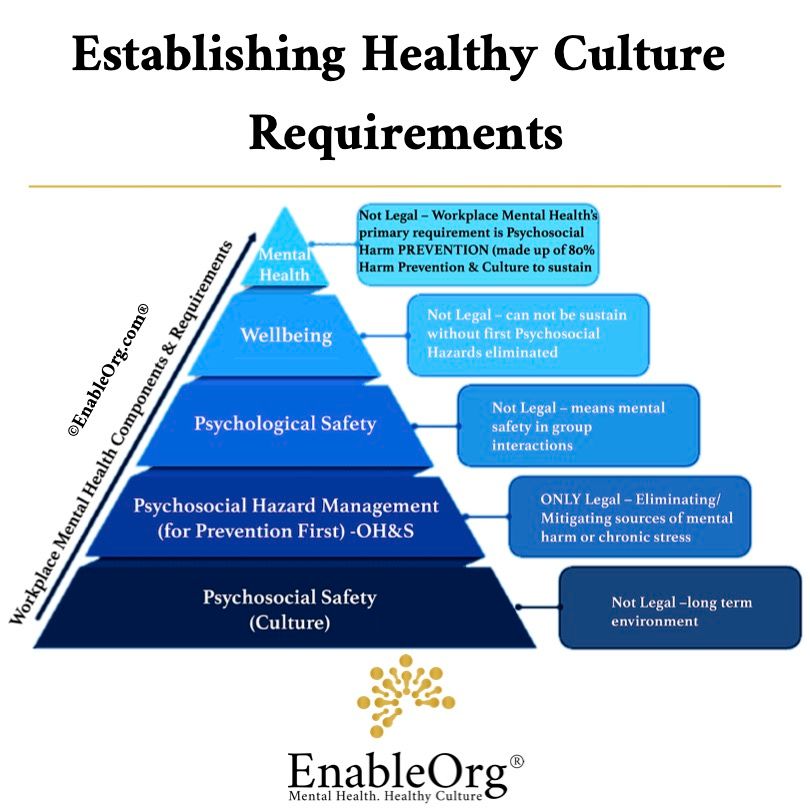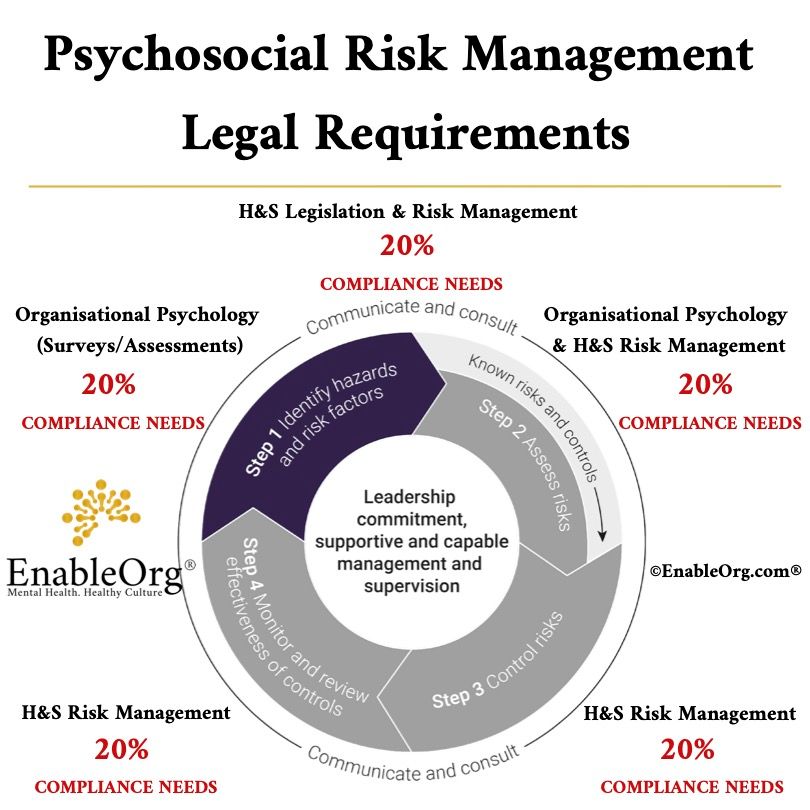Why the first Psychosocial prosecution cited ‘Culture’ as the cause. Legal Requirements for Psychosocial Risks, Vs Work Design, and ISO 45003 explained.
)
Dr Ranjeeta Singh delves into the intersection of psychosocial prosecution and cultural factors as a cause. She examines the legal obligations surrounding psychosocial risks and compares them with concepts such as psychological safety, well-being, work design, and the ISO 45003 standard. The first psychosocial prosecution serves as a backdrop to understand the significance of culture in contributing to such risks. By exploring legal requirements and standards, Dr Singh aims to elucidate the complexities involved in addressing psychosocial risks in the workplace and highlights the importance of considering cultural factors in this endeavour.
First Psychosocial Prosecution: Systems Vs Culture
The first WorkSafe bullying prosecution, Court Services Victoria fined $380k for ‘toxic’ workplace, with findings pointing to Culture, not work design or ISO, highlights the need to understand the difference between culture and systems. And the limitations of a system i.e. Work Design and ISO 45003. And I’ll qualify that by adding that I’m a professional Health & Safety lead auditor with a PhD in organisational psychology. And also worked for the people that invented ISO as an ISO trainer. I know systems inside-out. And so I also know their intent, benefit, requirements. And limitations. And the misconceptions that widely account for people referring to Work Design as 'harm prevention'. Which it is not.
Systems are a framework. They are a collective technical think-tank output. Note the word 'technical'. Not human behaviour. Systems are a collection of interrelated steps that make a whole by being carried out in a certain sequence or collective sequences. Systems are where strategy, information, tools, pathways, infrastructure and other resources are aligned and utilised to achieve an outcome. They are a pathway to get an outcome. Work design is a set of rules to help minimise cumulative physical task related injury, which also impacts psychological chronic stress, towards fixing repetitive, monotonous jobs. Essentially Work Design is an 'engagement' job system. Org. psychs. call this ‘harm prevention’. It isn’t.
The widespread misconception is that Work Design is a psychosocial harm prevention tool. Psychosocial risk are sources of harm from social and psychological factors arising within the workplace. Ask yourself if bullying is a Psychosocial factor. If the answer is yes, it is definitely caused by social and psychological factors, then how is Work Design ever going to be harm prevention here. Is making your job less monotonous going to prevent social and psychological factors resulting in bullying. No. Because Work Design is not a Psychosocial Harm Prevention fix. It is a systems harm anticipation framework for job engagement.

Similarly ISO 45003 is a wider system. For the whole organisation. To line up the overall strategy, leadership, planning, resources, operations, continual improvement and review process frameworks. That's all it is. And to highlight how ISO 45003 isn't a harm prevention fix, clause 6 asks you to IDENTIFY your workplace social and psychological risk factors. When something is asking you to identify the problem, it cannot itself fix the problem. It is drawing your attention to the need to figure out what the root-cause social and psychological factors to begin with. Root-cause analysis is the source of actual harm prevention.
And these are the limitations of systems. They give you the framework only. The bones. Work design and ISO 45003 don't give you the will, commitment and crucially, the knowledge, needed to fill the bones. Which requires IDENTIFYING specific social and psychological risks (compiling a list of things you think are social and psychological risks is harm anticipation, not harm prevention. They may be real issues present, they may not be). This will, commitment and knowledge is by far the more important factor, by about 80%, compared to systems, for harm prevention. The latter ‘will, commitment and knowledge’ is part of the workings of culture.
Culture is 'the way we do things around here'.
If 'the way we do things around here' is wait for suicide by bullying, high turnover from toxicity, wait for findings by legally appointed investigators to say we ignored key repeated toxic behaviours of sexual harassment, bury things when reported, victim blame, then no amount of 'work design', ISO 45003, wellbeing training or Safe Works list of Psychosocial Risk management items is going to fix or prevent these issues. They will at best just band-aid them for an audit or investigation, which is likely the only time any of these will be taken seriously in this type of culture. If 'the way we do things around here' is to really pay attention to staff needs and concerns, to get objective data driven transparency on what these are to best support them robustly, to specifically look for issues at the grass roots, before waiting for harm to happen and be reported, then that is the only way to prevent psychosocial harm and mental injury. This is a healthy culture. Culture dictates everything within a workplace.
And that's why WorkSafe concluded that the root-cause was Culture. The foundational requirement for everything to work. No system will have sustained benefits without foundational culture support. And that's also why WorkSafe prosecuted. Because the very foundations needed where lacking. The Culture. If the Culture was committed to doing the right thing, but they were some Work Design and ISO 45003 failings, prosecution would unlikely have been pursued.

Why fix Culture. First?
We all know about workplace bullying, toxic workplace, mental harm, etc. But largely people look to piece-meal solutions for that specific downstream issue. Guaranteed Work Design and ISO 45003 are not going to 'prevent' bullying, sexually harassment, toxic colleagues. The foundation root-cause of ALL of these is Culture. Psychosocial Risk management for Harm Prevention is only possible by establishing cultural fixes.
But addressing these cultural issues is also responsible for all the other desired individual benefits like good physical and mental health, creativity, innovation, learning and development, as well as the organisational desirability’s like lower safety incidents (physical and psychological), lower quality defects, lower turnover, decreased revenue loss, optimised business operations. And more. Culture is driving force for Safety (Physical & Psychosocial), Wellbeing, Engagement, Quality, Productivity, Innovation, Learning & Development and Optimising every facet of the workplace.
Address Culture. Reap the benefits 10s fold.
Systems are important. And useful. But they are only a complimentary support system to the most important employee Mental Health and Healthy Workplace requirement, the Culture. The system will only map out a structured way to get there. It is the culture that will get you there.
ISO 45003, systems, mental health, psychosocial terms & wellbeing for mental health explained
Since Covid heightened the platform for the need and the rise and rise of workplace mental health, the only thing that has spread faster is the confusion and misconception of the related concepts that entail it.
THE most important requirement for workplace mental health and a psychologically safe workplace is by far its culture. Culture and the other key requirement to workplace mental health and a psychologically safe workplace make about 80% of the requirements for workplace mental health and a psychologically safe workplace. This other requirement being psychosocial safety. PsychoSOCIAL safety is almost always confused with the lesser useful psychoLOGICAL safety. Psychological Safety does not establish culture. It is the result of culture.
The most misunderstood concept by far is Psychological Safety and the ‘magic’ fix to everything this is. Psychological Safety is team dynamics in feeling safe to speak up, that’s all. Psychological Safety also does not result in a psychologically safe workplace or employees. It is somewhere in the middle of all the necessities to having mental health and a psychological safe workplace. There are two key requirements that make up the majority of workplace mental health and a psychologically safe workplace. PsychoSOCIAL safety & Culture. First.

The second most important workplace mental health and a psychologically safe workplace requirement is PSYCHOSOCIAL SAFETY. Psychosocial safety comes from eliminating and mitigating sources of psychological and social chronic stress within the workplace, that will impact psychological and physical health. This is also the only legal requirement of all workplaces within the mental health workings required. Together, psychosocial safety and culture make up about 80% of the requirements for psychologically safe employees and workplace.

Before wellbeing can have any benefit, psychosocial safety and culture must be mitigated and harm eliminated where possible. And to highlight exactly how much misconception there is that these are the same things or that wellbeing results in mental health, a study showing that despite global efforts into wellbeing, distress among employees remained high. Because the key to mental health is culture and psychosocial safety. Not wellbeing.
They are a very few legitimate reasons for not meeting legislative requirements in mitigated or removing workplace psychosocial harm. The legislation states ‘where reasonably practicable’. The thing most people don’t realise is that the legislation requires anyone managing psychosocial harm, consultants, trainers, apps, software, managers, to be qualified in BOTH H&S Risk management AND organisational psychology, exactly so that the expertise to establish exactly what IS ‘reasonably practicable ’exists. Only having H&S training and thinking of psychological hazards in the same way as physical hazards and trying to manage them with bowties & swim-lanes will likely result in legislative breaches, as psychological hazards do not behave, at all, like physical risks. Only having organisational psychology and thinking work design is harm prevention will likely result in legislative breaches. Calling yourself an ISO 45003 trainer or ISO auditor with only a certificate of having attended a 2–4-day course will likely result in legislative breaches.
Legal requirements for meeting Psychosocial Risk Management
Like most things ‘new’, especially in the internet age, there is no end of statements and discussions on what, how, when, which model. And like most things on the internet, more is not better. And so psychosocial risk management is the latest victim of misinformation. With work places genuinely wanting to get it right and with so many ‘professionals’ themselves so misinformed, having slim chances of getting clarity and robust implementation themselves.
The legal requirement to manage psychosocial hazards is not ‘new’. It’s been in the Health and Safety legislation, UK, Australia, NZ and others, for well over a decade. All countries Health and Safety legislations and high-level requirements all come from one source, the International Labour Organisation, a part of the World Health Organisation. Key word being ‘Health’. The Health and Safety regulations have always incorporated physical and mental health. It’s just that no one paid much attention to the ‘mental’ part because it was too hard and so ‘who cares’. Until COVID. When mental health suffered and was brought to the forefront globally. Then, again, thanks to the sea of misinformation of the internet, everyone threw ‘wellbeing’ at the mental distress. Which absolutely does not lead to mental health.
Most countries requirements for managing psychological hazards are pretty similar, with the differences coming down to technical things like how much personal, company fines and imprisonment each country faces, which hierarchy of control is preferred. The tiers of personal penalty and prosecution. The requirement to prevent harm as the starting point is across the board. Then mitigate. The term in legislation of ‘competent’, ‘expertise’ and ‘qualified’ is across the board. The test of this legal requirement to be competent/expertise in the field and qualified is tertiary qualifications. Not google. Not LinkedIn. Not 2 day ISO courses. Anyone implementing and managing Psychosocial Risk Management without tertiary qualifications in the required area is not meeting legal requirements, for the organisation and for themselves and leaves both vulnerable to personal fines and, depending on what the risk factors and fallouts are, prosecution.
The other key words used throughout legislative requirements is ‘reasonably foreseeable’ and ‘reasonably practicable’. Here’s where the tertiary qualifications needed specifically for the psychosocial part of the becomes quite distinct. For physical hazard management we all have it drummed into us, and no reputable organisation would hire anyone without this, H&S risk management tertiary qualifications. No tertiary H&S qualifications, no job as a H&S manager. Or competent consultant. Psychosocial hazards, part of the same legislative requirements, are so much more complex than physical hazards. The qualifications to manage these competently then is NOT going to be less expertise and competency than managing physical hazards.
In order to legislatively meet the criteria for Psychosocial Risk Management for ‘competent’, ‘expertise’, who are then equipped with the appropriate judgement and skill set to ‘reasonably foresee’ and decide what is ‘reasonably practicable’, tertiary qualifications in BOTH H&S risk management AND Organisational Psychology. For managers, consultants, software providers and apps. Anyone implementing and managing in the Psychosocial Risk Management space must fulfil these dual requirements.
A person cannot possibly judge ‘reasonably foreseeable’ and ‘reasonably practicable’ if they are not qualified to understand organisational psychological needs and interactions AND how to manage risks within H&S legislative needs. This means any Psychosocial manager,/implementor, consultant, software, app not having tertiary qualifications in H&S risk management AND Organisational Psychology behind them is leaving the organisation open to fines and prosecution, themselves to the same and leaving the organisation open to more risk. And employees possibly even more vulnerable to psychosocial risks that often comes from a false sense of security leading to increased complacency.
The realistic need for dual qualifications comes from knowing the implementing needs of risk management. Psychological assessments carried out by organisational psychologists, consultant firms and most software’s that only measure and suggest corrections, only fulfil about 20% of legal requirements.
A survey collection of psychosocial risks and some suggested fixes’ is not Psychosocial Risk Management. It does NOT meet legal compliance. It is only a psychosocial EVALUATION.
The remaining 80% of compliance needs still come from subject-matter-expertise of Risk management (a whole complex field in its own right) combined with H&S management and legislation requirements across duty holders.

Key components of Psychosocial Risk management for Compliance:
1. Psychosocial Risk Identification. Often survey based. This needs to be carried out using psychologically VALIDATED surveys. In-house, self-developed surveys are not meeting compliance. Psychosocial is not the same as psychological safety. Organisation Psychology qualifications needed – 20% of Compliance needs fulfilled only
2. Psychosocial Risk Assessment. This is evaluating the outcomes of the preceding step. Qualified expertise is needed to interpret these, both psychologically as well as knowing how and what the risks mean, individually and cumulatively. Organisation Psychology AND H&S Risk Management qualifications needed – 20% of Compliance needs fulfilled only
3. Psychosocial Controls. This is critical in requiring a very robust knowledge of what controls are, how to implement them, which don’t compete with BAU or other workplace factors. Organisation Psychology AND H&S Risk Management qualification needed – 20% of Compliance needs fulfilled only
4. Psychosocial Control Reviewing. This is critical in requiring a very robust knowledge of what frequency to monitor controls at, how to implement cumulative control measures that don’t compete with BAU or other workplace factors, how to assess if you have the right controls in place. Organisation Psychology AND H&S Risk Management qualification needed – 20% of Compliance needs fulfilled only
5. Consultation. This does not merely mean asking people how the changes are going and their view on them with feedback. H&S legislation has specific stipulations on who is responsible for what throughout the organisation, from top level to manager to front-line. They all have different and some overlapping legal responsibilities. Consultation includes incorporating these tiered and varied requirements. H&S legislative Management qualification needed – 20% of Compliance needs fulfilled only
----
Dr Ranjeeta Singh is a Lead Auditor for Health & Safety, has been a BSI Executive ISO trainer across several varying Standards, an Executive Coach and is a current Board Director. Her PhD research focused on Psychosocial Risk, Wellbeing, Culture, Leadership & Resilience, in Positive Psychology & Organisational Behaviour.
She is the founder of EnableOrg® - Leading Experts in WHS Psychosocial Risk Management & Compliance, Mental Health, Healthy Culture & Benchmark Leadership™ development SaaS. AI powered to bring you future proof expertise for your Healthy Culture sustainable solutions.
Dr Ranjeeta Singh will speak at the Melbourne show on the topic of harm Prevention vs. harm Reaction, legal requirements for Psychosocial Risks, and Healthy Culture. This will be an expertise session for sustained Healthy Workplace establishment.

